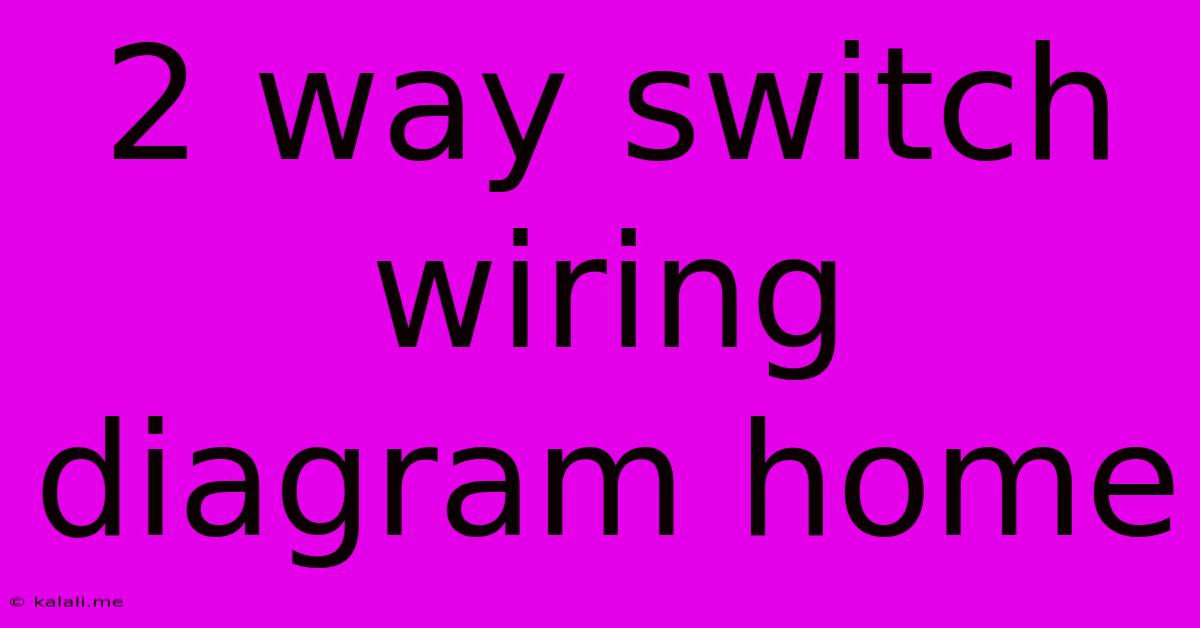2 Way Switch Wiring Diagram Home
Kalali
Jun 05, 2025 · 3 min read

Table of Contents
Understanding and Wiring a 2-Way Switch for Your Home
This article provides a comprehensive guide to understanding and wiring a two-way switch, a common electrical component used in homes to control a light or appliance from two different locations. We'll cover the basics, the wiring diagrams, and troubleshooting tips to help you confidently tackle this electrical project. Always remember to turn off the power at the breaker before starting any electrical work. Safety is paramount!
What is a 2-Way Switch?
A two-way switch, also known as a three-way switch (although technically different, they serve a similar purpose), allows you to control a light or other electrical device from two separate locations. This is extremely useful in hallways, staircases, or any area where a single switch placement isn't practical. Unlike a standard single-pole switch that has only two terminals, a two-way switch has three terminals. This additional terminal is crucial for the circuit's functionality.
Understanding the Wiring Diagram
The wiring diagram for a two-way switch setup involves two switches and the light fixture. The key is understanding the traveler wires. These wires carry the power signal between the two switches.
Here's a breakdown of the components:
- Live Wire (L): This wire carries the power from the electrical panel.
- Neutral Wire (N): This wire completes the circuit and provides a return path for the electricity. It's typically connected directly to the light fixture.
- Switch Wires: These are the wires connecting the two switches and the light fixture. One set will be the "common" wires (connected to the common terminal of each switch). Another set will be the "traveler" wires that carry the signal between the two switches.
Common Wiring Configurations:
There are several ways to wire a two-way switch, depending on the specific wiring in your home. However, the fundamental principles remain the same. Let's look at a standard configuration:
Wiring Diagram Example:
(Diagram would be shown here if this were a visual medium. Describe the diagram instead.)
Imagine a simple diagram with three key parts:
- Power Source: Showing the live (L) and neutral (N) wires entering the circuit.
- Switch 1: With three terminals labeled "Common," "Traveler 1," and "Traveler 2".
- Switch 2: Similar to Switch 1, with three terminals labelled identically.
- Light Fixture: Showing the connection for the neutral wire and the switch wires from Switch 2.
The live wire (L) connects to the "common" terminal of Switch 1. The traveler wires connect the "traveler 1" and "traveler 2" terminals of Switch 1 to the corresponding terminals of Switch 2. The other common terminal from Switch 2 goes to the light fixture. The light fixture is also connected to the neutral wire (N).
Troubleshooting Tips:
If your two-way switch isn't working correctly, here are some troubleshooting steps:
- Check the Breaker: Ensure the breaker supplying power to the circuit is switched on.
- Test the Wiring: Use a voltage tester to check for power at each terminal of the switches and the light fixture. Remember to turn off the power at the breaker first!
- Inspect the Wiring Connections: Look for loose or damaged wires.
- Check the Switches: Make sure the switches themselves are functioning correctly. Try replacing a switch if you suspect it's faulty.
- Examine the Light Fixture: Ensure the light bulb is functioning and properly connected.
Beyond the Basics: Advanced Configurations
While this article covers the basic principles of two-way switching, more complex setups involving multiple switches to control a single light are possible. These scenarios often involve intermediate switches and require a more detailed understanding of electrical wiring. Consult with a qualified electrician for these more advanced configurations.
By understanding the fundamentals presented here, you can confidently wire a two-way switch in your home, adding convenience and functionality to your electrical system. Always prioritize safety and consult a professional if you are unsure about any aspect of the process.
Latest Posts
Latest Posts
-
Typing Box Shows Up In Mac
Jun 06, 2025
-
Can You Replace A T12 With A T8
Jun 06, 2025
-
Do Metal Junction Boxes Need To Be Grounded
Jun 06, 2025
-
Difference Between Tomato Paste And Puree
Jun 06, 2025
-
Add Calculator To Home Screen Android
Jun 06, 2025
Related Post
Thank you for visiting our website which covers about 2 Way Switch Wiring Diagram Home . We hope the information provided has been useful to you. Feel free to contact us if you have any questions or need further assistance. See you next time and don't miss to bookmark.